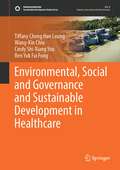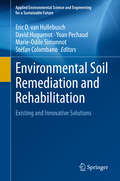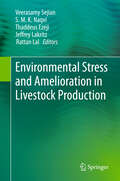- Table View
- List View
Environmental Simulation: Research and Policy Issues
by R. W. Marans Daniel StokolsThis volume is intended to provide an overview and scholarly analysis of state-of-the-art developments within the field of environmental simulation research. Environmental simulation involves the presentation of scale model previews, full-scale mock-ups, and computer images of planned environments and activities taking place within them to designers and to prospective users of those settings. Environmental simulations are under taken for many purposes, including (1) the training of environmental de sign students and professionals, (2) the assessment of people's environ mental preferences, and (3) the incorporation of observers' assessments of simulated settings into the planning, design, and renovation of actual envi ronments to maximize the degree of fit between occupants' needs and the arrangement of their physical surroundings. Environmental simulation research has expanded rapidly during the past two decades as the result of increasing collaboration between behav ioral and social scientists, environmental designers, and professional plan ners. During this period, alternative conceptual and methodological ap proaches to environmental simulation have emerged, and numerous programs of simulation research have been initiated worldwide. To date, however, no attempt has been made to present a comprehensive review and assessment of these research developments and an analysis of their implications for design and public policy. Accordingly, the major objectives of this volume are to provide an overview of key conceptual and meth odological advances within the field of environmental simulation research and to place these diverse developments within a broader scientific and public policy context.
Environmental Simulation Chambers: Application to Atmospheric Chemical Processes (Nato Science Series: IV: #62)
by Ian Barnes Krzysztof J. RudzinskiAtmospheric pollution has many different detrimental impacts on air quality at urban, regional and global scales. Large volume photoreactors (often referred to as smog or simulation chambers) have been used very effectively to investigate and understand many varied aspects of atmospheric chemistry related to air pollution problems. Photochemical smog formation, which was first observed around 1945 in Los Angeles, is now a major environmental problem for all industrialised and densely populated regions of the world. Over the years many different modelling and experimental tools have been developed to analyse and simulate the complex chemical processes associated with tropspheric photooxidant formation. Work in environmental chambers has played a key role in the development of our understanding of the atmospheric chemistry associated with pollution problems on local, regional and global scales. Chamber observations have also been used in connection with environmental policy issues. In general they are used for validation of atmospheric chemical models, studies of chemical reaction mechanisms and as a direct means to test the possible impact of specific chemical compounds on air quality under simulated ambient conditions New large smog chamber installations have been recently developed in the US (Riverside, California), Europe (Jülich, Germany) and Japan, and a large number of smaller scale laboratory chambers are in operation around the world. Over the years there have been numerous new technical developments related to environmental chamber facilities such as the design of the chambers (e. g.
Environmental, Social and Governance and Sustainable Development in Healthcare (Sustainable Development Goals Series)
by Ben Yuk Fong Tiffany Cheng Leung Wang-Kin Chiu Cindy Shi-Xiang YouThis book applies environmental, social and governance (ESG) to issues of sustainable development in healthcare. ESG reporting has been widely used for some time in the business industry to show the economic, social and environmental responsibilities of companies that aim to achieve superior ESG performance for lower risk, more accountability and transparency. Moreover, public-listed companies in healthcare have been growing in significant numbers in recent years. The application or practice of ESG in healthcare has become a growing trend for these large organisations looking to demonstrate their strengths in areas of financing, operations, sustainability and social responsibilities. Such an approach is essential not only for the long-term development of the companies but also for services delivered by healthcare practitioners. Equally, the implications to Sustainable Development Goal (SDG) 3 is relevant to healthcare worldwide with a growing ageing population, which has led to a great burden of care in many countries, particularly in the public sector. The potential development and expansion in private healthcare services, accelerated by technology advancement, has demanded a new paradigm in the healthcare industry, particularly in business, service delivery and policy. The book examines this paradigm through health in all policies, ESG and SDG 3 objectives, research, training and practice. It is relevant to graduate students and scholars working in areas relating to health, business and the SDGs and is also useful to policymakers and practitioners in healthcare.
Environmental Sociology: European Perspectives and Interdisciplinary Challenges (Studies In European Sociology Ser.)
by Matthias Gross Harald HeinrichsDespite being a relatively young sub-discipline, European environmental sociology has changed considerably in the last decades towards more interdisciplinary collaborations and problem solving. Current trends such as global environmental modernization and processes of economic, political and socio-cultural globalization, fuelled by developments of transport, environmental flows, scientific uncertainty, and information technologies, have fostered new conceptual approaches that move beyond classical sociological mind-sets toward broader attempts to connect to other disciplines.
Environmental Sociology
by John HanniganThe third edition of John Hannigan’s classic undergraduate text has been fully updated and revised to highlight contemporary trends and controversies within global environmental sociology. Environmental Sociology offers a distinctive, balanced treatment of environmental issues, reconciling Hannigan’s much-cited model of the social construction of environmental problems and controversies with an environmental justice perspective that stresses inequality and toxic threats to local communities.
Environmental Sociology
by John HanniganThe third edition of John Hannigan’s classic undergraduate text has been fully updated and revised to highlight contemporary trends and controversies within global environmental sociology. Environmental Sociology offers a distinctive, balanced treatment of environmental issues, reconciling Hannigan’s much-cited model of the social construction of environmental problems and controversies with an environmental justice perspective that stresses inequality and toxic threats to local communities.
Environmental Sociology
by John HanniganJohn Hannigan’s definitive textbook offers a distinctive, balanced coverage of environmental issues, policies and action. This revised fourth edition has been expanded and fully updated to explore contemporary developments and issues within global environmental sociology. Environmental Sociology reconciles Hannigan’s widely cited model of the social construction of environmental problems and controversies, which states that incipient environmental issues must be identified, researched, promoted and persuasively argued in the form of "claims", with an environmental justice perspective that stresses inequality and threats to local communities. For example, this new edition explores the interconnections between indigenous communities and environmental activists via a study of the difficult relationship between Aboriginal people and environmentalists in Australia. The updated fourth edition also discusses new direct action protest groups, such as Extinction Rebellion, who have reframed the discourse around the "climate emergency" using apocalyptic language and imagery. Environmental Sociology also signposts exciting new directions for future research. The fourth edition re-interrogates the classical roots of environmental theory with a focus of the work of Alexander von Humboldt. Hannigan also asserts the need for environmental sociologists to turn their attention to "The Forgotten Ocean", arguing that the discipline should incorporate cutting-edge concepts such as marine justice, striated space and volumetrics. Environmental Sociology is a key text for students and researchers in environmental studies, political ecology, social geography and environmental sociology.
Environmental Sociology
by John HanniganJohn Hannigan’s definitive textbook offers a distinctive, balanced coverage of environmental issues, policies and action. This revised fourth edition has been expanded and fully updated to explore contemporary developments and issues within global environmental sociology. Environmental Sociology reconciles Hannigan’s widely cited model of the social construction of environmental problems and controversies, which states that incipient environmental issues must be identified, researched, promoted and persuasively argued in the form of "claims", with an environmental justice perspective that stresses inequality and threats to local communities. For example, this new edition explores the interconnections between indigenous communities and environmental activists via a study of the difficult relationship between Aboriginal people and environmentalists in Australia. The updated fourth edition also discusses new direct action protest groups, such as Extinction Rebellion, who have reframed the discourse around the "climate emergency" using apocalyptic language and imagery. Environmental Sociology also signposts exciting new directions for future research. The fourth edition re-interrogates the classical roots of environmental theory with a focus of the work of Alexander von Humboldt. Hannigan also asserts the need for environmental sociologists to turn their attention to "The Forgotten Ocean", arguing that the discipline should incorporate cutting-edge concepts such as marine justice, striated space and volumetrics. Environmental Sociology is a key text for students and researchers in environmental studies, political ecology, social geography and environmental sociology.
Environmental Software Systems: Proceedings of the International Symposium on Environmental Software Systems, 1995 (IFIP Advances in Information and Communication Technology #39)
by Ralf Denzer Gerald Schimak David RussellDue to increasing practical needs, software support of environmental protection and research tasks is growing in importance and scope. Software systems help to monitor basic data, to maintain and process relevant environmental information, to analyze gathered information and to carry out decision processes, which often have to take into account complex alternatives with various side effects. Therefore software is an important tool for the environmental domain. When the first software systems in the environmental domain grew - 10 to 15 years ag- users and developers were not really aware of the complexity these systems are carrying with themselves: complexity with respect to entities, tasks and procedures. I guess nobody may have figured out at that time that the environmental domain would ask for solutions which information science would not be able to provide and - in several cases - can not provide until today. Therefore environmental informatics - as we call it today - is also an important domain of computer science itself, because practical solutions need to deal with very complex, interdisciplinary, distributed, integrated, sometimes badly defined, user-centered decision processes. I doubt somebody will state that we are already capable of building such integrated systems for end users for reasonable cost on a broad range. The development of the first scientific community for environmental informatics started around 1985 in Germany, becoming a technical committee and working group of the German Computer Society in 1987.
Environmental Software Systems: Environmental Information and Decision Support (IFIP Advances in Information and Communication Technology #39)
by Ralf Denzer David A. Swayne Martin Purvis Gerald SchimakEnvironmental Informatics (or Enviromatics) is a maturing subject with interdisciplinary roots in computer science, environmental planning, ecology, economics and other related areas. Its practitioners must be prepared to work with many diverse professional groups. It forms the foundation for computer-assisted environmental protection. This book contains an edited version of papers presented at the 3rd International Symposium on Environmental Software Systems (ISESS '99), which was held at the University of Otago, Dunedin, New Zealand, from August 30 to September 2, 1999, and was sponsored by the International Federation for Information Processing (IFIP). The text is divided into six sections: Enviromatics - Introduction; Environmental Issues; Environmental Information Systems - Tools and Techniques; Environmental Information Systems - Implementations; Environmental Decision Support Systems; Specialised Topics. This state-of-the-art volume will be essential reading for computer scientists and engineers, ecologists, and environmental planners and managers.
Environmental Software Systems: IFIP TC5 WG5.11 International Symposium on Environmental Software Systems (ISESS ’97), 28 April–2 May 1997, British Columbia, Canada (IFIP Advances in Information and Communication Technology)
by Ralf Denzer David A. Swayne Gerald SchimakEnvironmental Informatics is a fast growing field which deals with all methods from computer science, environmental planning, ecology and related subjects. As well as being an interdisciplinary area, Environmental Informatics provides an interface between all involved professional groups. Monitoring the state of the environment, analysing existing data, presenting the data to scientists and the public, as well as providing decision support are only some of the topics involved. Environmental Informatics is therefore a good foundation for the computer-assisted protection of the environment.
Environmental Soil Biology (Experimental and Clinical Neuroscience)
by M. WoodEnvironmental considerations are playing an increasingly important role in determining management strategies for soil and land. Many important environmental issues involve aspects of the biology of soil, and these issues cannot be considered satisfactorily in isolation from a general understanding of soil biology as a whole. This is the second edition of a book first published in 1989 and now thoroughly rewritten to focus on soil ecology and environmental issues. The first part of the book provides an introduction to soils, its inhabitants, and their activities. The second part covers the influence of man on the natural cycles of soil. Topics such as acid rain and nitrogen fertilizers are considered alongside pesticides and genetically modified organisms. A new final chapter has been added which considers how, as we move towards the next millennium, we can apply the concept of sustainability to issues such as global climate change and farming systems. The book is directed at advanced undergraduate and immediate postgraduate students in environmental science and soil ecology, with students of physical geography and earth sciences as an important secondary market.
Environmental Soil-Landscape Modeling: Geographic Information Technologies and Pedometrics
by Sabine GrunwaldEnvironmental Soil-Landscape Modeling: Geographic Information Technologies and Pedometrics presents the latest methodological developments in soil-landscape modeling. It analyzes many recently developed measurement tools, and explains computer-related and pedometric techniques that are invaluable in the modeling process. This volume provi
Environmental Soil Remediation and Rehabilitation: Existing and Innovative Solutions (Applied Environmental Science and Engineering for a Sustainable Future)
by Eric D. van Hullebusch David Huguenot Yoan Pechaud Marie-Odile Simonnot Stéfan ColombanoThis book provides a comprehensive overview of innovative remediation techniques and strategies for soils contaminated by heavy metals or organic compounds (e.g. petroleum hydrocarbons, NAPLs and chlorinated organic compounds). It discusses various novel chemical remediation approaches (in-situ and ex-situ) used alone and in combination with physical and/or thermal treatment. Further, it addresses the recovery of NAPLs, reuse of leaching solutions, and in-situ chemical reduction and oxidation, and explores the chemical enhancement of physical NAPLs recovery from both practical and theoretical perspectives. Also presenting the state-of-the-art in waste-assisted bioremediation to improve soil quality and the remediation of petroleum hydrocarbons, the book is a valuable resource for students, researchers and R&D professionals in industry engaged in the treatment of contaminated soils.
Environmental Soil Science (Books In Soils, Plants, And The Environment Ser.)
by Kim H. TanCompletely revised and updated, incorporating almost a decade's worth of developments in this field, Environmental Soil Science, Third Edition, explores the entire reach of the subject, beginning with soil properties and reactions and moving on to their relationship to environmental properties and reactions. Keeping the organization and writing sty
Environmental Standards: Combined Exposures and Their Effects on Human Beings and Their Environment
by Christian Streffer Josef Bücker Adrienne Cansier Dieter Cansier Carl Friedrich Gethmann Robert Guderian Gerd Hanekamp Dietrich Henschler Gerald Pöch Eckard Rehbinder Ortwin Renn Marco Slesina Kerstin WuttkeThe rapid growth of the world population - nearly six-fold over the last hundred years - combined with the rising number of technical installations especially in the industrialized countries has lead to ever tighter and more strained living spaces on our planet. Because ofthe inevitable processes oflife, man was at first an exploiter rather than a careful preserver of the environment. Environmental awareness with the intention to conserve the environment has grown only in the last few decades. Environmental standards have been defined and limit values have been set largely guided, however, by scientific and medical data on single exposures, while public opinion, on the other hand, now increasingly calls for astronger consideration of the more complex situations following combined exposures. Furthermore, it turned out that environmental standards, while necessarily based on scientific data, must also take into account ethical, legal, economic, and sociological aspects. A task of such complexity can only be dealt with appropriately in the framework of an inter disciplinary group.
Environmental Statistics and Data Analysis
by Wayne R. OttThis easy-to-understand introduction emphasizes the areas of probability theory and statistics that are important in environmental monitoring, data analysis, research, environmental field surveys, and environmental decision making. It communicates basic statistical theory with very little abstract mathematical notation, but without omitting importa
Environmental Statistics and Data Analysis
by Wayne R. OttThis easy-to-understand introduction emphasizes the areas of probability theory and statistics that are important in environmental monitoring, data analysis, research, environmental field surveys, and environmental decision making. It communicates basic statistical theory with very little abstract mathematical notation, but without omitting importa
Environmental Strategy and Planning in China
by Jinnan Wang Xiahui Wang Jun WanThis book covers the research fields in biodiversity conservation, the Belt and Road eco-environmental cooperation, China's five-year plan for eco-environmental protection, sustainable development goals assessment, and human health loss assessment. In the past, these achievements have played an important scientific role in supporting China's ecological and environmental protection, and produced extensive social impacts and significant environmental benefits. At the same time, the relevant research ideas and methods also show the latest progress and trend in the field of environmental strategy and planning in China in recent years, which can be used for reference by experts and scholars of other countries in the field of ecological environment.
Environmental Stratified Flows (CISM International Centre for Mechanical Sciences #479)
by Vincenzo Armenio Sutanu SarkarThis book covers the theory of stratified flows, from basic concepts to recent developments in environmental fluid mechanics. State-of-the-art numerical techniques suited for stratified flows are given, along with results of recent research in the areas of environmental stratified flows. The book offers a unified view of stratified turbulent flows, from small-scale mixing to large-scale environmental phenomena, including detailed discussion on interaction between turbulence and internal gravity waves.
Environmental Stratified Flows (Topics in Environmental Fluid Mechanics #3)
by Roger GrimshawThe dynamics of flows in density-stratified fluids has been and remains now an important topic for scientific enquiry. Such flows arise in many contexts, ranging from industrial settings to the oceanic and atmospheric environments. It is the latter topic which is the focus of this book. Both the ocean and atmosphere are characterised by the basic vertical density stratification, and this feature can affect the dynamics on all scales ranging from the micro-scale to the planetary scale. The aim of this book is to provide a “state-of-the-art” account of stratified flows as they are relevant to the ocean and atmosphere with a primary focus on meso-scale phenomena; that is, on phenomena whose time and space scales are such that the density stratification is a dominant effect, so that frictional and diffusive effects on the one hand and the effects of the earth’s rotation on the other hand can be regarded as of less importance. This in turn leads to an emphasis on internal waves.
Environmental Stress, Adaptation and Evolution (Experientia Supplementum #83)
by K. Bijlsma Volker LoeschckeMost organisms and populations have to cope with hostile environments, threatening their existence. Their ability to respond phenotypically and genetically to these challenges and to evolve adaptive mechanisms is, therefore, crucial. The contributions to this book aim at understanding, from a evolutionary perspective, the impact of stress on biological systems. Scientists, applying different approaches spanning from the molecular and the protein level to individuals, populations and ecosystems, explore how organisms adapt to extreme environments, how stress changes genetic structure and affects life histories, how organisms cope with thermal stress through acclimation, and how environmental and genetic stress induce fluctuating asymmetry, shape selection pressure and cause extinction of populations. Finally, it discusses the role of stress in evolutionary change, from stress induced mutations and selection to speciation and evolution at the geological time scale. The book contains reviews and novel scientific results on the subject. It will be of interest to both researchers and graduate students and may serve as a text for graduate courses.
Environmental Stress and Amelioration in Livestock Production
by Veerasamy Sejian, S.M.K. Naqvi, Thaddeus Ezeji, Jeffrey Lakritz and Rattan LalGiven the importance of livestock to the global economy, there is a substantial need for world-class reference material on the sustainable management of livestock in diverse eco-regions. With uncertain climates involving unpredictable extreme events (e.g., heat, drought, infectious disease), environmental stresses are becoming the most crucial factors affecting livestock productivity. By systematically and comprehensively addressing all aspects of environmental stresses and livestock productivity, this volume is a useful tool for understanding the various intricacies of stress physiology. With information and case studies collected and analyzed by professionals working in diversified ecological zones, this book explores the influence of the environment on livestock production across global biomes. The challenges the livestock industry faces in maintaining the delicate balance between animal welfare and production are also highlighted.
Environmental Stress and Behavioural Adaptation
by John DavenportIt is generally agreed that animal life originated in the sea and that adaptive radiation subsequently led to the colonisaHon of other environments - shores and estuaries, streams and lakes, bog, mountain and desert. In their invasion of these habitats animals left the equable, relatively stabl.e surroundings of the open sea and subjected themselves to the rigours of temperature fluctuations and extremes, a variety of ionic backgrounds, areas of depleted oxygen or the possibility of aerial exposure and potential desiccation. The spur for this radiation presumably lay in the prize of access to unexploited habitats and sources of energy. The survival of these more adventurous species has depended upon them evolving mechanisms to protect the integrity of their cellular constituents. Protoplasm can only exist within physiochemical limits which are quite narrow for each species. Water activity, salt and gas concentrations and temperature all have to be appropriate for enzyme catalysed processes to function properly within cells. Except in the open sea, environmental conditions regularly vary outside these limits. To take a familiar example; humans can only remain conscious (and hence functional) if their core (Le. deep tissues - brain, heart, liver, etc.) body temperature is maintained between about 30 and 43°C.
Environmental Stress in Plants: Biochemical and Physiological Mechanisms (Nato ASI Subseries G: #19)
by Joe H. CherryEnvironmental stresses represent the most limiting factors to agricultural productivity worldwide. Their impact is not only on presently cultivated crops, they are also significant barriers to the introduction of crop plants in noncultivated areas. A significant global problem in the improvement of agriculture is the major variation in annual crop yields due to variations in environmental stresses such as drought, flooding, salinity, and temperature variations. This summary presents current background and research knowledge on all important environmental stresses and their respective influence on plant growth, development and crop yield as well as on biochemical and physiological events within plant tissues in reaction to changing environmental conditions.





















